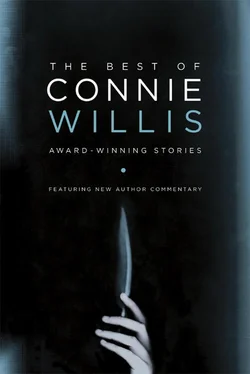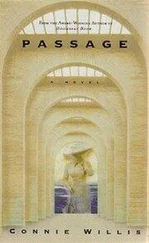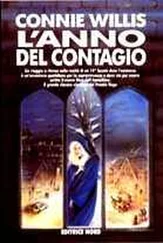“Wherever we’re going, we need to make up our minds,” the admirer said. “The afternoon session starts at two.”
“We can’t miss that,” the Old Man said. He looked around the circle. “So where are we going? Tom, are you coming to lunch with us?”
“I can’t,” I said. “I wish you’d come with me. It would be like old times.”
“Speaking of old times,” the Old Man said, turning back to the group, “I still haven’t told you about the time I got thrown out of Kismet . What was that harem girl’s name, Elliott?”
“Lalume,” Elliott said, turning to look at the Old Man, and I made my escape.
An inversion layer. Holding the air down so it couldn’t escape, trapping it belowground so that smoke and particulates, and smells, became concentrated, intensified.
I took the Tube back to Holborn and went down to the Central Line to look at the ventilation system. I found a couple of wall grates no larger than the size of a theater handbill and a louvered vent two-thirds of the way down the westbound passage, but no fans, nothing that moved the air or connected it with the outside.
There had to be one. The deep stations went down hundreds of feet. They couldn’t rely on nature recirculating the air, especially with diesel fumes and carbon monoxide from the traffic up above. There must be ventilation. But some of these tube stations had been built as long ago as the 1880s, and Holborn looked like it hadn’t been repaired since then.
I went out into the large room containing the escalators and stood looking up. It was open all the way to the ticket machines at the top, and the station had wide doors on three sides, all open to the outside.
Even without ventilation, the air would eventually make its way up and out onto the streets of London. Wind would blow in from outside, and rain, and the movement of the people hurrying through the station, up the escalators, down the passages, would circulate it. But if there was an inversion layer, trapping the air close to the ground, keeping it from escaping—
Pockets of carbon monoxide and deadly methane accumulated in coal mines. The Tube was a lot like a mine, with the complicated bendings and turnings of its tunnels. Could pockets of air have accumulated in the train tunnels, becoming more concentrated, more lethal, as time went by?
The inversion layer would explain why there were winds, but not what had caused them in the first place. An IRA bombing, like I had thought when I felt the first one? That would explain the blast and the smell of explosives, but not the formaldehyde. Or the stifling smell of dirt in Charing Cross.
A collapse of one of the tunnels? Or a train accident?
I made the long trek back up to the station and asked the guard next to the ticket machines, “Do these tunnels ever collapse?”
“Oh, no, sir, they’re quite safe.” He smiled reassuringly. “There’s no need to worry.”
“But there must be accidents occasionally,” I said.
“I assure you, sir, the London Underground is the safest in the world.”
“What about bombings?” I asked. “The IRA—”
“The IRA has signed the peace agreement,” he said, looking at me suspiciously.
A few more questions, and I was likely to find myself arrested as an IRA bomber. I would have to ask the Old—Elliott. And in the meantime, I could try to find out if there were winds in all the stations or just a few.
“Can you show me how to get to the Tower of London?” I asked him, extending my tube map like a tourist.
“Yes, sir, you take the Central Line, that’s this red line, to Bank,” he said, tracing his finger along the map, “and then change to the District and Circle. And don’t worry. The London Underground is perfectly safe.”
Except for the winds, I thought, getting on the escalator. I got out a pen and marked an X on the stations I’d been to as I rode down. Marble Arch, Charing Cross, Sloane Square.
I hadn’t been to Russell Square. I rode there and waited in the passages and then on both platforms through two trains.
There wasn’t anything at Russell Square, but on the Metropolitan Line at St. Pancras there was the same shattering blast as at Charing Cross—heat and the acrid smells of sulfur and violent destruction.
There wasn’t anything at Barbican, or Aldgate, and I thought I knew why. At both of them the tracks were aboveground, with the platform open to the air. The winds would disperse naturally instead of being trapped, which meant I could eliminate most of the suburban stations.
But St. Paul’s and Chancery Lane were both underground, with deep, drafty tunnels, and there was nothing in either of them except a faint scent of diesel and mildew. There must be some other factor at work.
It isn’t the line they’re on, I thought, riding toward Warren Street. Marble Arch and Holborn were on the Central Line, but Charing Cross wasn’t, and neither was St. Pancras. Maybe it was the convergence of them. Chancery Lane, St. Paul’s, and Russell Square all had only one line. Holborn had two lines, and Charing Cross had three. St. Pancras had five.
Those are the stations I should be checking, I thought, the ones where multiple lines meet, the ones honeycombed with tunnels and passages and turns. Monument, I thought, looking at the circles where green and purple and red lines converged. Baker Street and Moorgate.
Baker Street was closest, but hard to get to. Even though I was only two stops away, I’d have to switch over at Euston, take the Northern going the other way back to St. Pancras, and catch the Bakerloo. I was glad Cath wasn’t here to say, “I thought you said it was easy to get anywhere on the Tube.”
Cath! I’d forgotten all about meeting her at the hotel so we could go to dinner with the Hugheses.
What time was it? Only five, thank God. I looked hastily at the map. Good. Northern down to Leicester Square and then the Piccadilly Line, and who says it isn’t easy to get anywhere on the Tube? I’d be to the Connaught in less than half an hour.
And when I got there I’d tell Cath about the winds, even if she did hate the Tube. I’d tell her about all of it, the Old Man and the charnel house smell and the old man in the plaid jacket.
But she wasn’t there. She’d left a note on the pillow of my bed. “Meet you at Grimaldi’s. 7 P.M.”
No explanation. Not even a signature, and the note looked hasty, scribbled. What if Sara called? I wondered, a thought as chilly as the wind in Marble Arch. What if Cath had been right about her, the way she’d been right about the Old Man?
But when I got to Grimaldi’s, it turned out she’d only been shopping. “The woman in the china department at Fortnum and Mason’s told me about a place in Bond Street that specialized in discontinued patterns.”
Bond Street. It was a wonder we hadn’t run into each other. But she wasn’t in the tube station, I thought with a flash of resentment. She was safely aboveground in a taxi.
“They didn’t have it, either,” she said, “but the clerk suggested I try a shop next door to the Portmeirion store which was clear out in Kensington. It took the rest of the day. How was the conference? Was Arthur there?”
You know he was, I thought. She had foreseen his having gotten old, she’d tried to warn me that first morning in the hotel, and I hadn’t believed her.
“How was he?” Cath asked.
You already know, I thought bitterly. Your antennae pick up vibrations from everybody. Except your husband.
And even if I tried to tell her, she’d be too wrapped up in her precious china pattern to even hear me.
“He’s fine,” I said. “We had lunch and then spent the whole afternoon together. He hadn’t changed a bit.”
“Is he going to the play with us?”
Читать дальше












